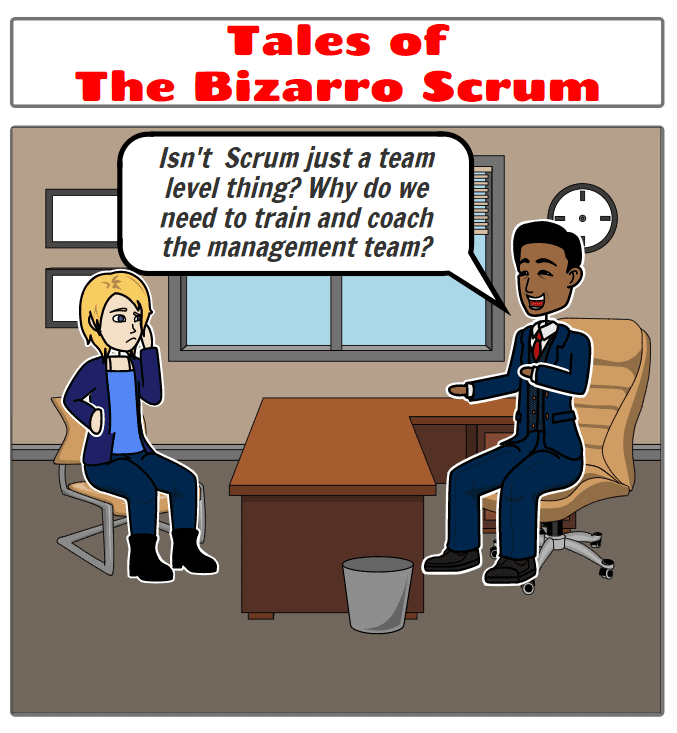Executive: “Isn’t Scrum just a team level thing? Why do we need to train and coach the management team?”
This sentiment is a common misunderstanding. However, for Scrum to be effective, it requires a change in organizational culture and operations. Without these changes, organization end up implementing Scrum-fall, Scrum-but, or Dark Scrum. It’s where everybody is using new cool lingo with new roles and titles, but besides that, it is really business as usual with minimal to no real improvements over their existing approach to software development.
Scrum is based on empiricism. That is, we learn best by trying something, inspecting it, and then adapting and improving based on what we learned. This applies to both what we are building, as well as how we are building it. This is a big paradigm shift from our traditional big up-front planning, followed by execution and control. In Scrum, we are simultaneously uncovering requirements and developing them at the same time, ensuring that what we are building is valuable and ensuring that we can actually build it. This inspect and adapt cycle requires close collaboration between the business and IT. Scrum breaks down the silos between business and IT by having a Product Owner from the business join the Scrum team so that they can work together daily, progressively elaborate on the requirements, and continuously validate the product increment.
Scrum also breaks down the silos within IT by creating a collaborative self-organizing Scrum development team consisting of all the cross functional skill sets that a team needs to take an idea or concept from the product backlog and convert it into a product increment in production.
For Scrum to be successful, Scrum requires a change in how most teams operate as well as a change in organizational culture. From an operational perspective, roles and responsibilities are re-aligned and silos are removed. There is a shift on organizing around and funding products over projects. From a cultural perspective, adopting the Agile values and principles are key to success. This includes a focus on customer satisfaction, welcoming changing requirements, delivering early and often, strong collaboration across the organization and breaking down of silos, establishing trust, working at a sustainable pace, building quality-in, focusing on outcomes and not output, simplifying organizational structures and product architectures, fostering self-organization and letting go of command and control, creating a safe to fail environment and continuously learning and improving.
All of this requires strong support from management and a move to Agile leadership. Without management setting a proper vision of how they want to transform their organization and leading the way for the change, any Agile or Scrum effort will fizzle.
- Tales of the Bizarro Scrum
- Tales of the Bizarro Scrum – Developers and Deliverables
- Tales of the Bizarro Scrum – Are You Sure It’s Going to Take this Long?
- Tales of the Bizarro Scrum – The BAs are Holding Us Back!
- Tales of the Bizarro Scrum – Yes, We Are a Self-organizing Team
- Tales of the Bizarro Scrum – Assigning Points to Everything
- Tales of the Bizarro Scrum – Isn’t Scrum Just a Team Level Thing?
- Tales of the Bizarro Scrum – The Code Freeze
- Tales of the Bizarro Scrum – Refining the upcoming 8 Sprints?
- Tales of the Bizarro Scrum – Of Course We Are Agile!
- Tales of the Bizarro Scrum – I’m Responsible for Writing User Stories
- Tales of the Bizarro Scrum – Scrum Master Canceling the Daily Scrum
- Tales of the Bizarro Scrum – The Sprint was a Colossal Failure
- Tales of the Bizarro Scrum – When is Sprint Planning?
- Tales of the Bizarro Scrum – Canceling the Sprint Retrospective
- Tales of the Bizarro Scrum – Product Owner Missing Sprint Planning?
- Tales of the Bizarro Scrum – Extending the Sprint
- Tales of the Bizarro Scrum – I’m the Product Owner and Scrum Master
